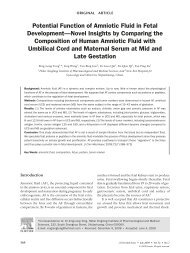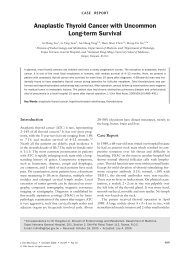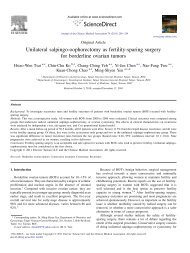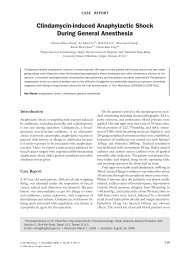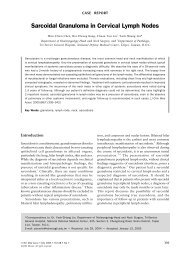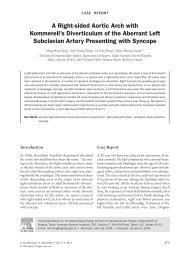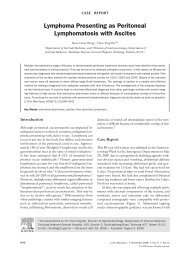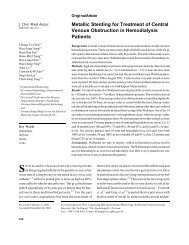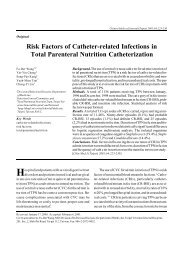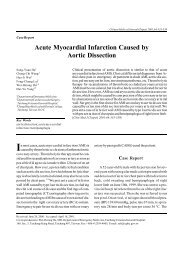Klinefelter's Syndrome with Seizure, Pseudohypoparathyroidism ...
Klinefelter's Syndrome with Seizure, Pseudohypoparathyroidism ...
Klinefelter's Syndrome with Seizure, Pseudohypoparathyroidism ...
You also want an ePaper? Increase the reach of your titles
YUMPU automatically turns print PDFs into web optimized ePapers that Google loves.
Introduction<br />
Klinefelter’s syndrome is one of the most common<br />
causes of hypogonadism, affecting 1 in 500 males.<br />
Two-thirds of affected individuals have a chromosomal<br />
karyotype of 47,XXY, while the remainder have variant<br />
and mosaic karyotypes. These men have androgen<br />
deficiency and impaired spermatogenesis due to<br />
testicular abnormalities. 1–3 Biopsy of the testes would<br />
show progressive hyalinization and fibrosis of the<br />
seminiferous tubules. The pituitary–gonadal system<br />
appears to function well until puberty, and then<br />
begins to show signs of change; gonadotropins are<br />
overproduced. In some patients <strong>with</strong> Klinefelter’s<br />
syndrome, the levels of follicle-stimulating hormone<br />
(FSH) and luteinizing hormone (LH) are up to 5<br />
times higher than normal. Testicular failure occurs<br />
before puberty; testosterone levels are low and normal<br />
pubertal changes do not occur. The characteristic<br />
CASE REPORT<br />
Klinefelter’s <strong>Syndrome</strong> <strong>with</strong> <strong>Seizure</strong>,<br />
<strong>Pseudohypoparathyroidism</strong> Type Ib and<br />
Multiple Endocrine Dysfunctions<br />
Chwen-Yi Yang*, Kao-Chang Lin 1 , Chien-Wen Chou, Ming-Bin Lin 2 , Su-Yu Chen, Hon-Mei Cheng<br />
Division of Endocrinology and Metabolism, Department of Medicine, and Departments of 1 Neurology<br />
and 2 Radiology, Chi-Mei Hospital, Tainan, Taiwan, R.O.C.<br />
Klinefelter’s syndrome is rarely associated <strong>with</strong> hypocalcemia, especially pseudohypoparathyroidism (PHP) type Ib.<br />
We describe a case of Klinefelter’s syndrome associated <strong>with</strong> seizure, PHP type Ib and multiple endocrine dysfunctions.<br />
A 19-year-old Taiwanese male was admitted due to seizures <strong>with</strong> loss of consciousness. He had been diagnosed<br />
<strong>with</strong> Klinefelter’s syndrome <strong>with</strong> seizure disorder and hypocalcemia 3 months previously. Physical examination revealed<br />
eunuchoidism but no osteodystrophy, while laboratory data revealed severe hypocalcemia, hyperphosphatemia, and<br />
elevated parathyroid hormone. Chromosomal study showed 47,XXY. Osteoporosis was found on chest and abdominal<br />
radiography. Dense calcification in the cerebrum and cerebellum was shown on brain computed tomography and<br />
magnetic resonance imaging. Elevation of the patient’s serum calcium level was noted after vitamin D and calcium<br />
carbonate supplements were given. Klinefelter’s syndrome is rarely associated <strong>with</strong> PHP type Ib; our patient’s<br />
hypocalcemia improved after long-term aggressive treatment. [J Chin Med Assoc 2005;68(12):585–590]<br />
Key Words: endocrine dysfunction, Klinefelter’s syndrome, pseudohypoparathyroidism type Ib<br />
features of eunuchoidism develop, including<br />
abnormally long limbs, absent facial, body and pubic<br />
hair, decreased muscle mass, gynecomastia, feminine<br />
distribution of adipose tissue, diminished libido, and<br />
small testes and penis. 1–3 Most of these changes occur<br />
during mid-to-late puberty.<br />
Clinical presentation is varied. Elevated gonadotropin<br />
levels, small testes, and impaired spermatogenesis<br />
are constant features. Gynecomastia, decreased facial<br />
and pubic hair, and low testosterone levels occur <strong>with</strong><br />
less frequency. 1–3 Klinefelter’s syndrome is associated<br />
<strong>with</strong> osteoporosis, autoimmune syndrome, endocrine<br />
disorders (diabetes mellitus, thyroid disease,<br />
hypogonadism), cancer, mental retardation, and psychiatric<br />
disturbances. 2 Klinefelter’s syndrome is rarely<br />
associated <strong>with</strong> hypocalcemia, especially pseudohypoparathyroidism<br />
(PHP) type Ib. We describe a<br />
case of Klinefelter’s syndrome associated <strong>with</strong> seizure,<br />
PHP type Ib and multiple endocrine dysfunctions.<br />
*Correspondence to: Dr. Chwen-Yi Yang, Division of Endocrinology and Metabolism, Department of Medicine, Chi-<br />
Mei Hospital, 901, Chung-Hwa Road, Yung-Kang City, Tainan 710, Taiwan, R.O.C.<br />
E-mail: fu9109@ms42.hinet.net • Received: December 20, 2004 • Accepted: July 7, 2005<br />
J Chin Med Assoc • December 2005 • Vol 68 • No 12 585<br />
©2005 Elsevier. All rights reserved.
Case Report<br />
A 19-year-old Taiwanese male <strong>with</strong> a 5-year history of<br />
syncope was admitted in August 2004 due to seizures<br />
<strong>with</strong> loss of consciousness. He was a senior high school<br />
student who performed poorly in school. The episodes<br />
of syncope generally persisted for 5 seconds to several<br />
minutes, <strong>with</strong> mild chest tightness, palpitations, nausea,<br />
headache, and eyes turned upward. They occurred at<br />
a frequency of several times a day to once in several<br />
months. He had previously visited a medical center for<br />
help <strong>with</strong>out obtaining a definitive diagnosis.<br />
Electrocardiography (ECG) and 24-hour Holter ECG<br />
monitoring showed nonspecific findings.<br />
The patient was first admitted to our neurologic<br />
section in May 2004 due to seizures. Laboratory data<br />
showed severe hypocalcemia (5.8 mg/dL; normal,<br />
8.4–10.2 mg/dL), high serum phosphorus (6.7 mg/<br />
dL; normal, 2.3–4.7 mg/dL), normal serum albumin<br />
(4.9 g/dL; normal, 3.8–5.3 g/dL), and high intact<br />
parathyroid hormone (PTH) (250 pg/mL; normal,<br />
10–60 pg/mL). Neck sonography showed a normal<br />
thyroid gland (Figure 1). Brain computed tomography<br />
(CT) and magnetic resonance imaging (MRI) revealed<br />
dense calcification in the cerebrum and cerebellum<br />
(Figures 2 and 3). An endocrinologist was consulted.<br />
Chromosomal study revealed that the patient had<br />
a karyotype of 47,XXY (Figure 4). Vitamin D<br />
(Rocaltrol ® , Roche, Basel, Switzerland) 0.25 µg/day<br />
and calcium carbonate 1,000 mg twice daily were<br />
given to raise the calcium level, and phenytoin 100 mg<br />
3 times daily was given to control seizures. After<br />
2 weeks of hospitalization, the patient was discharged<br />
in good condition. Despite aggressive treatment to<br />
correct the calcium deficit, hypocalcemia and hyperphosphatemia<br />
persisted. The patient continued to<br />
have occasional seizure episodes.<br />
In August 2004, he was again admitted due to<br />
seizures, <strong>with</strong> loss of consciousness. Physical examination<br />
revealed a tall and thin male (height, 178 cm;<br />
weight, 60 kg; body mass index, 18.9), <strong>with</strong> the<br />
characteristic features of eunuchoidism, including<br />
abnormally long limbs (width of open arms from<br />
finger tip to finger tip, 185 cm; lower/upper body<br />
ratio, 102/76 cm), absent facial, body and pubic<br />
hair, decreased muscle mass, mild gynecomastia,<br />
feminine distribution of adipose tissue, and small<br />
testes and penis. No osteodystrophy was found in his<br />
extremities.<br />
Hematologic investigation showed mild anemia<br />
<strong>with</strong> a hemoglobin level of 13.1 g/dL (normal, 13.5–<br />
17.5 g/dL) and hypereosinophilia, <strong>with</strong> a total<br />
eosinophil count of 759/µL (normal, < 350/µL).<br />
586<br />
C.Y. Yang, et al<br />
A B<br />
Figure 1. (A, B) Thyroid gland <strong>with</strong> normal size and echopattern is<br />
shown on neck sonography; there are no focal nodules. No obvious<br />
hypoechoic nodules are seen posterior to the thyroid gland.<br />
A B<br />
Figure 2. Computed tomography of the brain shows dense<br />
calcification in the bilateral putamen, caudate head, thalamus,<br />
cerebellar dentate nucleus and along bilateral frontoparietal gray<br />
white matter junctions <strong>with</strong>out midline shift. (A) Without contrast<br />
enhancement; (B) <strong>with</strong> contrast enhancement.<br />
A B<br />
C D<br />
Figure 3. Magnetic resonance imaging of the brain shows<br />
exaggerated intracranial calcification in the bilateral putamen,<br />
caudate head, and thalamus. (A) Axial view <strong>with</strong>out intravenous<br />
Gd-DTPA enhancement; (B) axial view <strong>with</strong> intravenous Gd-DTPA<br />
enhancement; (C) sagittal view; (D) coronal view.<br />
J Chin Med Assoc • December 2005 • Vol 68 • No 12
Figure 4. The patient had a 47,XXY karyotype.<br />
Biochemical studies revealed normal fasting blood<br />
glucose (95 mg/dL; normal, 70–110 mg/dL), low<br />
serum potassium (2.9 mmol/L; normal, 3.5–5.0<br />
mmol/L), low serum calcium (5.4 mg/dL; normal,<br />
8.4–10.2 mg/dL), and high serum phosphorus<br />
(7.2 mg/dL; normal, 2.3–4.7 mg/dL).<br />
Endocrinologic data showed mild subclinical<br />
hypothyroidism <strong>with</strong> normal antimicrosomal antibody<br />
(AMiA, TPO Ab) titer (< 100; normal titer, < 100),<br />
normal antithyroglobulin (ATA) titer (< 100; normal<br />
titer, < 100), normal triiodothyronine (112 ng/dL;<br />
normal, 80–170 ng/dL), normal thyroxine (7.1 µg/<br />
dL; normal, 4.5–12.5 µg/dL), high thyroidstimulating<br />
hormone (TSH) (5.9 µIU/mL; normal,<br />
0.2–4.0 µIU/mL), subclinical adrenal insufficiency<br />
<strong>with</strong> low 8 AM cortisol (5.3 µg/dL; normal, 6–23 µg/<br />
dL), normal 4 PM cortisol (8.2 µg/dL; normal, 3–14<br />
µg/dL), elevated adrenocorticotropic hormone<br />
(ACTH) (55.8 pg/mL; normal, 9–52 pg/mL),<br />
hypergonadotropic hypogonadism <strong>with</strong> high FSH<br />
(23 mIU/mL; normal, 1.4–1.8 mIU/mL), high LH<br />
(12.7 mIU/mL; normal for male < 70 years of age,<br />
1.5–9.3 mIU/mL), low testosterone (129 ng/dL;<br />
Klinefelter’s syndrome <strong>with</strong> pseudohypoparathyroidism<br />
normal, 241–827 ng/dL), elevated PTH <strong>with</strong> PTH-<br />
C (C-terminal) (1.43 ng/mL; normal, 0.4–1.4 ng/<br />
mL), and very high intact PTH (191.9 pg/mL;<br />
normal, 14–72 pg/mL) and PTH-MM (mid-portion)<br />
(126 pmol/L; normal, 40–100 pmol/L).<br />
Chest and abdominal radiography (Figure 5) and<br />
dual-energy X-ray absorptiometry (Figure 6) revealed<br />
osteoporotic changes in the bones. Skull sella views<br />
were negative. Follow-up brain CT and MRI revealed<br />
exaggerated intracranial calcification. The Mini-Mental<br />
State Examination (MMSE) and electroencephalography<br />
indicated mild cortical dysfunction.<br />
The patient was diagnosed <strong>with</strong> Klinefelter’s<br />
syndrome (47,XXY) <strong>with</strong> seizures, PHP type Ib<br />
(hypocalcemia, hyperphosphatemia, elevated<br />
parathyroid hormone) and multiple endocrine<br />
dysfunctions (hypergonadotropic hypogonadism,<br />
subclinical hypothyroidism, subclinical adrenal<br />
insufficiency). We increased the dosage of vitamin D<br />
from 0.25 µg to 0.5 µg daily, and the calcium carbonate<br />
dose from 1,000 mg twice daily to 1,000 mg 4 times<br />
daily. Testosterone replacement therapy was initiated<br />
<strong>with</strong> testosterone enanthate (Testenan depot, Sinton<br />
Ltd, Sin-Chu City, Taiwan) 250 mg twice monthly.<br />
Follow-up outpatient data showed improved<br />
hypocalcemia and hyperphosphatemia. After 10 months<br />
of treatment from May 1, 2004 to March 3, 2005, the<br />
patient’s serum calcium level had increased from<br />
5.8 mg/dL to 7.5 mg/dL, and the serum phosphorus<br />
level had decreased from 6.7 mg/dL to 6.4 mg/dL.<br />
However, mild subclinical hypothyroidism and mild<br />
adrenal insufficiency persisted (triiodothyronine,<br />
129.7 ng/dL; thyroxine, 6.2 µg/dL; TSH, 4.2 µIU/<br />
mL; random cortisol, 2.9 µg/dL).<br />
A B<br />
Figure 5. (A) Chest film obtained in the standing position shows<br />
no definite bony fracture, normal heart size, and no active lung<br />
lesions, but osteoporotic change is seen. (B) Abdominal film<br />
obtained in the supine position revealed no pathologic calcification,<br />
normal intestinal gas pattern, and normal pelvic fat lines, but<br />
osteoporotic change is seen.<br />
J Chin Med Assoc • December 2005 • Vol 68 • No 12 587
Discussion<br />
588<br />
a Right Hip<br />
Reference Database*<br />
*Age, gender and ethnicity matched<br />
Figure 6. Proximal femoral bone mineral density (BMD) as measured<br />
by dual-energy X-ray absorptiometry revealed that the BMD of the<br />
proximal femoral at the neck, trochanter, inter, total and ward’s<br />
regions were 0.726, 0.618, 0.971, 0.818, and 0.713 g/cm 2 ,<br />
respectively. The overall BMD of the neck was 0.726 g/cm 2 , which<br />
is about –1.26 T-score compared <strong>with</strong> normal young peak bone<br />
mass and no z-score in comparison <strong>with</strong> similar age-, gender-, and<br />
ethnicity-matched controls. Grade I osteoporosis was diagnosed.<br />
Both PTH and 1,25(OH) 2D function to maintain<br />
normal serum calcium levels and are central to<br />
preventing hypocalcemia. The causes of hypocalcemia<br />
can be classified into: (1) hypoparathyroidism; (2)<br />
resistance to PTH action; (3) failure to produce 1,25<br />
(OH) 2D normally; (4) resistance to 1,25(OH) 2D; and<br />
(5) acute complexation or deposition of calcium. 4<br />
Most of the signs and symptoms of hypocalcemia<br />
occur because of increased neuromuscular excitability<br />
(tetany, paresthesia, seizure, organic brain syndrome)<br />
or because of calcium deposition in soft tissues (cataract,<br />
calcification of basal ganglia). 4,5 Our patient’s laboratory<br />
data revealed intractable hypocalcemia and<br />
hyperphosphatemia, while brain CT and MRI showed<br />
C.Y. Yang, et al<br />
exaggerated intracranial calcification (including basal<br />
ganglia); he had seizures and loss of consciousness,<br />
which were compatible <strong>with</strong> the signs and symptoms<br />
of hypocalcemia.<br />
PHP is a heritable disorder of target-organ<br />
unresponsiveness to PTH. Biochemically, it mimics<br />
hormone-deficient forms of hypoparathyroidism <strong>with</strong><br />
hypocalcemia and hyperphosphatemia, but the PTH<br />
level is elevated and there is a markedly blunted<br />
response to the administration of PTH in PHP. To<br />
confirm that resistance to PTH is present, the patient is<br />
challenged <strong>with</strong> PTH (the Ellsworth-Howard test). 4,5<br />
Several distinct forms of PHP are recognized,<br />
including PHP types Ia, Ib, Ic, II, and pseudo-PHP. 5<br />
PHP type Ia is caused by the loss of 1 functional allele<br />
of the gene encoding the G protein subunit G sα,<br />
which leads to a 50% deficiency in the heterotrimer G s,<br />
which couples the PTH receptor to adenylyl cyclase.<br />
The mutation results in generalized disorder of<br />
hormonal unresponsiveness. PHP type Ia is inherited<br />
as an autosomal dominant trait. Primary<br />
hypothyroidism and abnormalities of reproductive<br />
function commonly occur, indicating that resistance<br />
to TSH, glucagon and gonadotropins are commonly<br />
present, but the response to ACTH is fairly normal.<br />
The G s mutation invariably produces Albright’s<br />
hereditary osteodystrophy (AHO), which consists of<br />
short stature, round face, short neck, brachydactyly,<br />
shortening of the fourth and fifth metacarpals, and<br />
subcutaneous ossifications.<br />
PHP type Ib is a disorder of isolated resistance<br />
to PTH but <strong>with</strong> no somatic phenotype (AHO),<br />
which presents <strong>with</strong> the biochemical features of hypocalcemia,<br />
hyperphosphatemia and secondary<br />
hyperparathyroidism. G s is normal in PHP type Ib.<br />
The locus responsible for PHP Ib resides on<br />
chromosome 20q13.3, the same region that contains<br />
the GNAS1 gene, encoding G sα. 5 The pattern of<br />
disease inheritance appears to be characteristic of<br />
PHP Ia, but mapping studies suggest that the<br />
mutations are close to but distinct from the G sαencoding<br />
region. 4,5 Our patient had biochemical<br />
features of hypocalcemia, hyperphosphatemia, and<br />
high PTH, but <strong>with</strong> no AHO, which is compatible<br />
<strong>with</strong> PHP type Ib. He also had multiple endocrine<br />
dysfunctions <strong>with</strong> hypergonadotropic hypogonadism,<br />
subclinical hypothyroidism, and subclinical adrenal<br />
insufficiency, which are not compatible <strong>with</strong> PHP<br />
type Ib but are associated <strong>with</strong> Klinefelter’s syndrome.<br />
Klinefelter’s syndrome is associated <strong>with</strong> many<br />
conditions. These include osteoporosis, because<br />
androgen deficiency is a major risk factor for<br />
osteoporosis (androgen stimulates osteoid formation<br />
J Chin Med Assoc • December 2005 • Vol 68 • No 12
and bone mineralization). Up to 50% of patients <strong>with</strong><br />
Klinefelter’s syndrome have bone mineral densities<br />
that are 12–15% lower than normal. 2 Autoimmune<br />
diseases, especially systemic lupus erythematosus<br />
and rheumatoid arthritis, are also associated <strong>with</strong><br />
Klinefelter’s syndrome. 6 Their pathogenic mechanism<br />
is unclear but may be related to testosterone and<br />
estrogen levels. Androgens are generally believed to<br />
protect against estrogen-facilitated autoimmunity. It<br />
seems more likely that autoimmunity is directly related<br />
to the extra X chromosome. Additionally, other<br />
endocrine disorders are associated <strong>with</strong> Klinefelter’s<br />
syndrome. 7,8 The incidence of diabetes mellitus is<br />
higher than normal among patients <strong>with</strong> Klinefelter’s<br />
syndrome: 8% of patients are symptomatic, while 29%<br />
have impaired glucose tolerance. The underlying<br />
mechanism for this is unknown; severely reduced<br />
insulin sensitivity and insulin resistance have been<br />
proposed. 7 There are diminished thyroid hormone<br />
reserves, but a definite connection between Klinefelter’s<br />
syndrome and hypothyroidism is lacking. 2 Graves’<br />
disease has also been reported to be associated <strong>with</strong><br />
Klinefelter’s syndrome, and an autoimmune mechanism<br />
was considered. 9 Usually, the patient’s adrenal gland<br />
function is normal. Our patient had normal blood<br />
glucose, normal thyroid antibody titer, and normal<br />
thyroid sonography picture, but he had mild subclinical<br />
hypothyroidism and subclinical adrenal insufficiency.<br />
The causes of the hypothyroidism and adrenal<br />
insufficiency remain unknown. We did not give our<br />
patient any levothyroxine or steroid supplement. Longterm<br />
follow-up is mandatory.<br />
Breast cancer is 20 times more frequent among<br />
men <strong>with</strong> Klinefelter’s syndrome (it typically<br />
represents only 0.5% of all cancers in men). 2 Patients<br />
have gynecomastia, which may predispose to<br />
malignancy. Extragonadal germ cell tumors are also<br />
more frequent. Malignant transformation of germ<br />
cells is presumably related to the persistent elevation<br />
of gonadotropin levels. 10,11 Mental retardation is<br />
common among men and boys <strong>with</strong> Klinefelter’s<br />
syndrome. 2 The prevalence of Klinefelter’s syndrome<br />
in mental and penal institutions is 1%. 2 Patients <strong>with</strong><br />
Klinefelter’s syndrome are predisposed to criminal<br />
behavior. Boys <strong>with</strong> an extra X chromosome tend to<br />
perform poorly in school, have low verbal scores,<br />
poor short-term auditory memory, poor data retrieval<br />
skills, delayed or diminished speech and language<br />
skills, or dyslexia.<br />
Patients <strong>with</strong> Klinefelter’s syndrome are prone to<br />
psychiatric disturbances ranging from anxiety, neurosis,<br />
depression, and lack of self-esteem to feelings of<br />
insecurity. 2 Patients <strong>with</strong> 48,XXXY or 49,XXXXY<br />
Klinefelter’s syndrome <strong>with</strong> pseudohypoparathyroidism<br />
karyotypes have greater difficulties than those <strong>with</strong><br />
47,XXY karyotypes, suggesting a correlation <strong>with</strong> the<br />
supernumerary X chromosomes rather than <strong>with</strong><br />
androgen levels. Our patient had poor performance in<br />
school, low-to-moderate intelligence, osteoporosis,<br />
and multiple endocrine disorders compatible <strong>with</strong><br />
some conditions of Klinefelter’s syndrome. He is at<br />
risk of developing autoimmune disease or cancer, so<br />
long-term follow-up is, thus, required.<br />
Klinefelter’s syndrome is also associated <strong>with</strong> mixed<br />
connective tissue disease, 12 Rathke’s cleft cyst, 13<br />
mediastinal polyembryoma, 14 hematologic malignancies,<br />
15 seizures, 16 and striatocapsular infarct. 17<br />
Klinefelter’s syndrome is rarely associated <strong>with</strong><br />
hypocalcemia. Sulimani 18 described a case of<br />
Klinefelter’s syndrome <strong>with</strong> PHP in a Saudi patient,<br />
while Poungvarin and Viriyavejakul 19 described a<br />
case of myotonia congenita, Klinefelter’s syndrome<br />
and primary hypoparathyroidism. The relationship<br />
between Klinefelter’s syndrome and PHP remains<br />
unknown.<br />
The treatment of Klinefelter’s syndrome begins<br />
<strong>with</strong> testosterone replacement therapy at 11–12 years<br />
of age. The most widely used form of therapy is an<br />
intramuscular preparation of testosterone enanthate<br />
or testosterone cypionate; the typical dose is 200 mg<br />
twice monthly. When initiated during puberty, the<br />
dose is lower: 50–100 mg every 4 weeks, then, every<br />
2 weeks until adulthood. A transdermal testosterone<br />
patch can be applied to other areas of the body and the<br />
scrotal surface, but is more expensive and has not been<br />
evaluated in patients younger than 18 years of age. 20<br />
Intracytoplasmic sperm injection of testicular<br />
spermatozoa obtained from men <strong>with</strong> Klinefelter’s<br />
syndrome has resulted in several deliveries. 21<br />
The benefits of testosterone replacement therapy<br />
include increased facial and pubic hair, a more masculine<br />
deposition of body fat, increased strength, and increased<br />
libido. Testicular size, gynecomastia, and<br />
sterility are not affected. 20 Our patient received testosterone<br />
enanthate 250 mg twice a week (although<br />
he began therapy late); he requires long-term followup<br />
to assess the benefits of therapy.<br />
Oral calcium and 1α-hydroxylated vitamin D<br />
metabolites remain the mainstay of treatment of<br />
PHP. 4,5 PTH has been used experimentally for the<br />
treatment of hypoparathyroidism but is not proven for<br />
therapy. Monitoring of serum and urinary calcium<br />
levels should be performed as in the treatment of<br />
vitamin D deficiency. Therapy in these patients is<br />
lifelong. The objective of chronic therapy is to maintain<br />
serum calcium in the low-normal range (approximately<br />
8.5–9.2 mg/dL) <strong>with</strong>out causing frank hypercalciuria, 4<br />
J Chin Med Assoc • December 2005 • Vol 68 • No 12 589
ut difficulties in attaining these therapeutic goals are<br />
often encountered. Oral calcium can be given as a dose<br />
of 1.5–3 g of elemental calcium per day. Short-acting<br />
vitamin D (calcitriol) and very long-acting vitamin D 2<br />
(ergocalciferol) are available. 4 Our patient received<br />
synthetic calcitriol 0.5 µg/day and calcium carbonate<br />
4,000 mg (1.6 g elemental calcium) per day; after 10<br />
months of treatment, his serum calcium level had<br />
elevated to 7.5 mg/dL (from 5.8 mg/dL). Longterm<br />
treatment is needed to correct the patient’s<br />
serum calcium level.<br />
In conclusion, Klinefelter’s syndrome is rarely<br />
associated <strong>with</strong> PHP type Ib. Our patient had improved<br />
hypocalcemia after long-term aggressive treatment<br />
<strong>with</strong> vitamin D and calcium supplementation.<br />
References<br />
1. Amory JK, Anawalt BD, Paulsen CA, Bremner WJ. Klinefelter’s<br />
syndrome. Lancet 2000;356:333–5.<br />
2. Smyth CM, Bremner WJ. Klinefelter syndrome. Arch Intern<br />
Med 1998;158:1309–14.<br />
3. Paulsen CA, Gordan DL, Carpenter RW, Gandy HM, Drucker<br />
WD. Klinefelter’s syndrome and its variant: a hormonal and<br />
chromosomal study. Recent Prog Horm Res 1968;24:321–63.<br />
4. Shoback D, Marcus R, Bikle D, Strewler G. Mineral metabolism<br />
and metabolic bone disease. In: Greenspan FS, Gardner DG,<br />
eds. Basic and Clinical Endocrinology, 6 th edition. New York:<br />
McGraw-Hill, 2001:273–333.<br />
5. Bringhurst FR, Demay MB, Kronenberg HM. Hormones and<br />
disorders of mineral metabolism. In: Larsen PR, Kronenberg<br />
HM, Melmed S, Polonsky KS, eds, Williams Textbook of<br />
Endocrinology, 10 th edition. Philadelphia: WB Saunders, 2003:<br />
1303–71.<br />
6. Kobayashi S, Yamamoto S, Tanaka M, Hashimoto H, Hirose<br />
S. Klinefelter’s syndrome and rheumatoid arthritis: report of a<br />
case and review of literature. Clin Rheumatol 1994;13:500–3.<br />
7. Ota K, Suehiro T, Ikeda Y, Arii K, Kumon Y, Hashimoto K.<br />
Diabetes mellitus associated <strong>with</strong> Klinefelter’s syndrome: a<br />
case report and review in Japan. Intern Med 2002;41:842–7.<br />
8. Tojo K, Kaguchi Y, Tokudome G, Kawamura T, Abe A, Sakai<br />
O. 47,XXY/46,XY mosaic Klinefelter’s syndrome presenting<br />
590<br />
C.Y. Yang, et al<br />
<strong>with</strong> multiple endocrine abnormalities. Intern Med 1996;35:<br />
396–402.<br />
9. Park JS, Kim CS, Nam JY, Kim DM, Yoon SJ, Ahn CW, Cha<br />
BS, et al. Graves’ disease associated <strong>with</strong> Klinefelter’s syndrome.<br />
Yonsei Med J 2004;45:341–4.<br />
10. Prall JA, McGavran L, Greffe BS, Partington MD. Intracranial<br />
malignant germ cell tumor <strong>with</strong> Klinefelter’s syndrome: case<br />
report and review of the literature. Pediatr Neurosurg 1995;<br />
23:219–24.<br />
11. Kaido T, Sasaoka Y, Hashimoto H, Taira K. De novo germinoma<br />
in the brain in association <strong>with</strong> Klinefelter’s syndrome: a case<br />
report. Surg Neurol 2003;60:553–8.<br />
12. Takeuchi Y, Murata Y, Sintani J, Masukawa H, Nakamura R,<br />
Oi K, Kato Y, et al. Klinefelter’s syndrome accompanied by<br />
mixed connective tissue disease and diabetes mellitus. Intern<br />
Med 1999;38:875–81.<br />
13. Gotoh M, Nakano J, Midorikawa S, Niimura S, Ono Y,<br />
Mizuno K. Multiple endocrine disorders and Rathke’s cleft<br />
cyst <strong>with</strong> Klinefelter’s syndrome: a case report. Endocr J 2002;<br />
49:523–9.<br />
14. Beresford L, Fernandez CV, Cummings E, Sanderson S, Ming-<br />
Yu W, Giacomantonio M. Mediastinal polyembryoma associated<br />
<strong>with</strong> Klinefelter syndrome. J Pediatr Hematol Oncol 2003;25:<br />
321–3.<br />
15. Keung YK, Buss D, Chauvenet A, Pettenati M. Hematologic<br />
malignancies and Klinefelter syndrome: a chance association?<br />
Cancer Genet Cytogenet 2002;139:9–13.<br />
16. Tatum WO 4th, Passaro EA, Elia M, Guerrini R, Gieron M,<br />
Genton P. <strong>Seizure</strong>s in Klinefelter’s syndrome. Pediatr Neurol<br />
1998;19:275–8.<br />
17. Perla C, Sanchez R, Alfaro A, Gilsanz A, Dominguez F.<br />
Striatocapsular infarct in a young patient <strong>with</strong> heterozygous<br />
familial hypercholesterolemia and Klinefelter’s syndrome.<br />
Medicina Clinica 1993;101:746–9.<br />
18. Sulimani RA. <strong>Pseudohypoparathyroidism</strong> in a Saudi patient<br />
<strong>with</strong> Klinefelter’s syndrome: case report. East Afr Med J 1998;<br />
75:252–3.<br />
19. Poungvarin N, Viriyavejakul A. Myotonia congenita, Klinefelter<br />
syndrome and primary hypoparathyroidism: the first report of<br />
the unusual combination of three rare diseases in the literature.<br />
J Med Assoc Thai 1991;74:172–5.<br />
20. Bagatell CJ, Bremner WJ. Androgen in men—uses and abuses.<br />
N Engl J Med 1996;334:707–14.<br />
21. Palermo GD, Schlegel PN, Sills ES, Veeck LL, Zaninovic N,<br />
Menendez S, Rosenwaks Z. Births after intracytoplasmic<br />
injection of sperm obtained by testicular extraction from men<br />
<strong>with</strong> nonmosaic Klinefelter’s syndrome. N Engl J Med 1998;<br />
338:588–90.<br />
J Chin Med Assoc • December 2005 • Vol 68 • No 12



